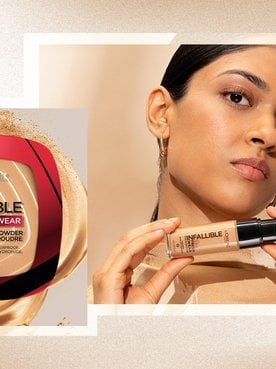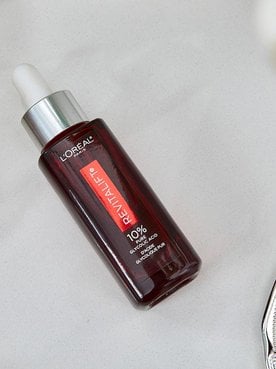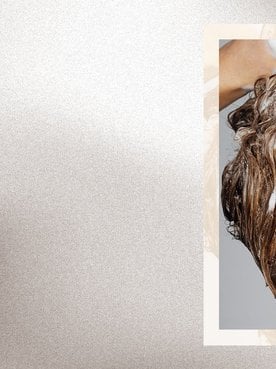Standing in the beauty aisle can be fun—or it can be overwhelming. It tends to fall into the latter category when you're trying to pick new skin care products, but you're not sure which ones to choose because you don't know what your skin type is. If you've ever asked, "What is my skin type?" you're not alone, but knowing your skin type really is key for learning how to care for your complexion. For example, dry skin types are going to want to follow a different routine than those who have oily skin. Ready to cut down on the confusion? Follow along as we help answer “what type of skin do I have” and find a routine that's tailored to your skin care concerns.
WHAT ARE THE FIVE TYPES OF SKIN?
Let's start off with the basics: There are five main skin types, which are normal, oily, dry, combination, and sensitive. Figuring out which type your skin falls into means knowing the hallmarks of each one, so here they are.
Normal skin: Normal skin is just what it sounds like—normal! It means having skin that is neither excessively oily nor very prone to dryness. It's the middle ground, and if you have normal skin, you should consider yourself very lucky!
Oily skin: Having oily skin means having a complexion that's prone to greasiness and shine by mid-day. This is easy to spot since, according to the American Academy of Dermatology, oily skin looks shiny.
Dry skin: In contrast to oily skin, dry skin types are constantly seeking moisture. According to the AAD, dry skin can look flakey and sometimes even feel itchy.
Combination skin: Combination skin is one skin type that can be tricky to manage. According to the AAD, those with combination skin may notice that their T-zone (which includes the forehead, nose, and chin) is oily, while their cheeks tend to be dry.
Sensitive skin: If you have sensitive skin, you may notice your complexion stings or burns when certain products are used, per the AAD.
HOW CAN YOU IDENTIFY YOUR SKIN TYPE?
While you’re now educated on the different common skin types, that may not necessarily clear up which one you have. Still wondering, ‘What type of skin do I have?’ The best way to identify your skin type is to simply pay attention to your skin. For example, if you feel like you're dealing with two different skin types at the same time, you're working with combination skin. If you notice that you're sporting a greasy-looking complexion all over your face, you have oily skin.
On the other hand, if your skin is thirsty for moisture, it's a tell-tale sign that you have dry skin. Feel like your skin is constantly irritated? You likely have sensitive skin. And if you never have to deal with excess oils, dryness, or flaky skin, you're working with normal skin.
WHAT IS THE MOST COMMON SKIN TYPE?
It's typically agreed that the most common skin type is combination skin. When it comes to being oily or dry, for most people, it isn't all or nothing—they have some patches of dry skin and some areas of oily skin.
WHAT'S THE DIFFERENCE BETWEEN NORMAL AND COMBINATION SKIN?
Are normal and combination skin the same thing? Nope. While neither type is all oily or dry, they’re actually pretty different. Normal skin doesn't have to deal with excess oils or dryness. So, caring for this skin type is a bit simpler than the others. On the flip side, combination skin will be oily, dry, and normal in various areas. Think of combination skin as dealing with multiple skin types at the same time.
CAN YOU CHANGE YOUR SKIN TYPE?
While skin conditions can change based on the seasons, your skin care routine, and various other factors, you can't actually change your skin type. Your skin type refers to your skin's natural state. If you only experience dry patches when you use a certain product, for example, you wouldn't actually be classified as having a dry skin type. Of course, the fact that you can't change your skin type isn't to say you can't manage it and achieve a balanced complexion. For example, oily skin types can be cared for in such a way that they aren't overly oily.
WHAT IS THE BEST SKIN TYPE TO HAVE?
Like it or not, there is no such thing as having the best skin type. The truth is, all skin types deal with various skin care concerns. The key is to give your skin the TLC it deserves and tailor your routine so that you can manage your specific concerns.
THE BEST SKIN CARE ROUTINE FOR YOUR SKIN TYPE
Once you've determined which skin type you have, learn what skin care routine is best for your complexion's needs.
A SKIN CARE ROUTINE FOR NORMAL SKIN
If you have normal skin, congratulations! Your skin isn't too oily or too dry. Follow this routine to keep your normal skin in order.
STEP 1: CLEANSE
Normal skin types can follow this motto: stick to simple. A gentle cleanser should be enough to help keep your skin clean and healthy. The L’Oréal Paris Micellar Cleansing Water Complete Cleanser Waterproof - All Skin Types removes makeup (even waterproof mascara!) and dirt in just one step, making it a perfect pick. Saturate a cotton pad with the cleansing liquid and sweep it across your face until completely clean—no harsh rubbing or rinsing required.
STEP 2: MOISTURIZE
You can get away with using an array of different moisturizer types, but we recommend the L’Oréal Paris Revitalift Triple Power Anti-Aging Moisturizer. The formula works to hydrate your skin while reducing wrinkles, firming, and brightening your complexion.
STEP 3: APPLY EYE CREAM
Even if the skin surrounding your eyes isn't particularly dry, it doesn't hurt to start using eye cream regularly, as the area around your eyes is often the first to show signs of aging. The L’Oréal Paris Eye Defense is a light, non-greasy gel-cream that is specially formulated to defend against premature signs of aging around the eyes.
STEP 4: DON'T FORGET SUNSCREEN
No matter your skin type, wearing broad-spectrum sunscreen—and taking other sun protection measures—is a must. Use a broad-spectrum sunscreen with an SPF value of 15 or higher daily, reapply every two hours (or immediately after swimming or sweating), cover-up exposed areas, seek shade, and limit your amount of time in the sun, especially during the hours of 10 a.m. to 2 p.m., as recommended by the Food and Drug Administration.
Editor's note: Are you game for taking your sun protection to the next level? Head on over to our article, What Is Your Fitzpatrick Skin Type?, for all the details on a different set of skin types—ones that impact how to protect your skin from the sun.
A SKIN CARE ROUTINE FOR OILY SKIN
Spotting an oily complexion is typically not difficult. In fact, if you have one, you probably already know and just need to find out how to care for it. Here's the best skin care routine for oil-prone skin types.
STEP 1: CLEANSE
What's better than cleansing your face once? Doing it twice! We're talking about double cleansing, which just might be something you want to try if you have oily skin. Your first cleanse should help remove makeup and dirt from the surface of your skin, while your second cleanse should remove any remaining impurities. Start with a simple rinse-free option like the L’Oréal Paris Ideal Clean™ All Skin Types Makeup Removing Towelettes. Then, follow up with a rinse-off cleanser, like the L’Oréal Paris Pure-Clay Detox & Brighten Cleanser.
STEP 2: EXFOLIATE
Dead skin cells and excess oils can build up on your skin, which can lead to your skin looking extra-oily. So, reach for an exfoliating scrub, like the L’Oréal Paris Pure-Sugar Purify & Unclog Kiwi Scrub, which gently exfoliates dull, dead skin cells from skin's surface and removes traces of oil, dirt, and makeup. There's no right or wrong answer as to how often you should exfoliate—some people can handle doing it every day, while others may only be able to do so once or twice a week. Pay attention to how your skin responds to determine what works best for you.
STEP 3: MOISTURIZE
Just because you have oily skin doesn't mean you can't benefit from moisturizing. In fact, moisturizer should be part of every single skin care routine, no matter your skin type. And the key is to find one that's right for your skin type. The L’Oréal Paris Hydra Genius Daily Liquid Care - Normal/Oily Skin is a lightweight, oil-free moisturizer that is formulated with aloe vera water and hyaluronic acid to help provide long-lasting hydration. Plus, it’ll leave your complexion with a matte finish—perfect for oily skin.
STEP 4: DOT ON EYE CREAM
Similarly to how everyone should use moisturizer, everyone can benefit from the use of eye cream. The L’Oréal Paris Age Perfect Hydra Nutrition Manuka Honey Eye Gel is formulated to glide on smoothly for an immediate smoothing effect and cool, fresh finish.
STEP 5: APPLY SUNSCREEN
Again, you shouldn't skip out on broad-spectrum sunscreen—and taking other sun protection measures—if you have oily skin. Look for an oil-free, non-comedogenic formula, and remember to apply daily before going outside and reapply often—as well as limiting your time in the sun and covering up exposed areas.
A SKIN CARE ROUTINE FOR DRY SKIN
Since dry skin types are prone to irritation, such as itchy and flaky skin, a soothing, hydrating skin care routine is key! Keep things simple with our step-by-step routine below.
STEP 1: CLEANSE
When your skin feels as dry as the desert, the last thing you likely want to do is wash your face. That's why it's important to pick a facial cleanser formulated for your skin type. Try the L’Oréal Paris Revitalift Radiant Smoothing Cream Cleanser, which is specially formulated to nourish skin and boost radiance while gently exfoliating and removing all traces of impurities and makeup.
STEP 2: EXFOLIATE
Dead skin cells and excess oils can build up on your skin, which can lead to a dull appearance. So, reach for an exfoliating scrub, like the L’Oréal Paris Pure-Sugar Nourish & Soften Cocoa Scrub, which gently exfoliates dull, dead skin cells from skin's surface and removes traces of oil, dirt, and makeup. Remember, there's no right or wrong answer as to how often you should exfoliate—some people can handle doing it every day, while others may only be able to do so once or twice a week. Listen to your skin and determine what works best for you.
STEP 3: MOISTURIZE
Now it's time to find a moisturizer that's formulated for dry skin! The L’Oréal Paris Hydra Genius Daily Liquid Care - Normal/Dry Skin and L’Oréal Paris Hydra Genius Daily Liquid Care - Extra Dry Skin are both formulated with aloe vera water and hyaluronic acid, enveloping skin with moisture. Smooth your moisturizer of choice over your face and neck.
STEP 4: APPLY EYE CREAM
If the rest of your face is dry, the skin around your eyes could be, too. This delicate, thin-skinned area is even more prone to dryness than the rest of your complexion. So, look for a hydrating eye cream, like the L’Oréal Paris Age Perfect Eye Renewal Eye Cream, which is formulated with precious oils for all-day hydration and comfort.
STEP 5: PROTECT WITH SUNSCREEN
If you have dry skin, look for a moisturizing broad-spectrum sunscreen. Apply it daily as the last step in your morning skin care routine, then make sure to take other sun protection measures, like limiting your sun exposure, seeking shade whenever possible, and throwing on protective accessories like a broad-brimmed hat and sunglasses.
A SKIN CARE ROUTINE FOR COMBINATION SKIN
Think you might have combination skin? Here's what to do.
STEP 1: CLEANSE
If you have combination skin that's oily in some areas but dry in others, look for a face wash that works on all skin types, like the L’Oréal Paris Ideal Clean™ All Skin Types Foaming Gel Cleanser, and use it to cleanse morning and night.
STEP 2: MOISTURIZER WITH SPF
Make things easy on yourself by applying a moisturizer formulated with broad-spectrum sunscreen, like the L’Oréal Paris Revitalift Bright Reveal Brightening Day Lotion SPF 30. Toss it in your tote so that you can reapply on the go—and be sure to limit your amount of time in the sun, especially during peak hours. It also never hurts to throw on a hat and sunglasses, too!
STEP 3: APPLY EYE CREAM
Just as with every other skin type we've covered so far, now's the time to reach for an eye cream and dab it lightly onto your under-eye area.
STEP 4: MULTI-MASK
Indulging in a face mask is one of the best ways to pamper your skin. If you have combination skin, try multi-masking—we're talking about applying different masks to different areas of your face at the same time—to address your various skin concerns. Take your pick of the L’Oréal Paris Pure-Clay Detox & Brighten Mask, L’Oréal Paris Pure-Clay Exfoliate & Refining Mask, and L’Oréal Paris Pure-Clay Clarify & Smooth Face Mask. Apply your masks of choice to clean, dry skin, leave on for 10 to 15 minutes, then rinse off.
A SKIN CARE ROUTINE FOR SENSITIVE SKIN
If you have sensitive skin, stick to products that are specifically formulated for your skin type to avoid irritation.
STEP 1: CLEANSE
First, you’ll need to use a soothing cleanser to wash your face. The L’Oréal Paris Age Perfect Nourishing Cream Cleanser is formulated with replenishing oils to help cleanse skin without over-drying, making it a perfect option for those with sensitive skin.
STEP 2: MOISTURIZE
Look for a moisturizer that's specifically formulated for your skin type, like the L’Oréal Paris Revitalift Cicacream Face Moisturizer Pro Retinol & Centella Asiatica. This nourishing option works all day to help refresh and hydrate skin while helping prevent visible signs of aging.
STEP 3: USE AN EYE CREAM
Dot on the L’Oréal Paris Revitalift Anti-Wrinkle + Firming Eye Cream to help hydrate your under-eye area.
STEP 4: APPLY SPF
As always, applying SPF is a must! Smooth one on as the last step in your morning skin care routine to protect your sensitive complexion.
STEP 5: USE A SOOTHING FACE MASK
If your skin becomes irritated, a soothing face mask can do wonders. The L’Oréal Paris Pure-Clay Clear & Comfort Mask is formulated with seaweed extract and three pure clays to clear and comfort stressed, uncomfortable skin.
Next: Your Daily, Weekly, and Monthly Skin Care Routines
August 14, 2020


Hi, I'm Beauty Genius, your new AI Beauty Assistant
Powered by Generative AI, I'll help you build a personalized routine and find the perfect products for you.
This site is intended for US consumers. Cookies and related technology are used for advertising. To learn more, or opt-out, visit AdChoices and our privacy policy.
Your Privacy Choices






